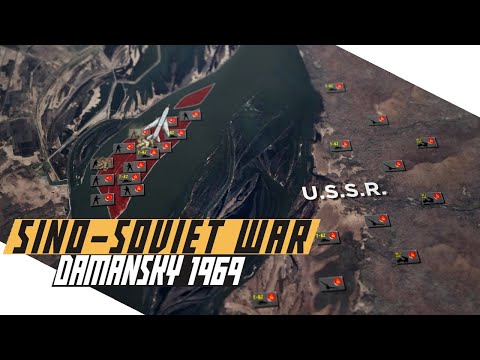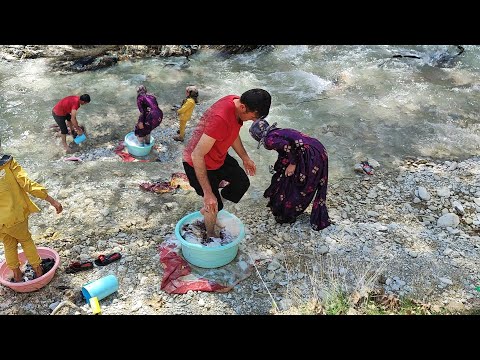Damansky incident - How China and USSR Almost Went to War - Cold War

Sino-Soviet relations are the redheaded stepchild of the Cold War. We know they are there, we know they are important but for many, they aren’t as important as other facets of the Cold War. And yet China and the Soviet Union, once Socialist brothers in arms, almost went to war with each other, and the threat of a nuclear exchange became very real in the minds of those paying attention. We aren’t going to go deep into the reasons for the Sino-Soviet Split, we’ve looked at those in an earlier episode. Instead, this week on the Cold War Channel, we are going to
look at the 1969 Sino-Soviet Border conflict. I’m your host David and this is…The Cold War. We do need to start with a bit of background. The Sino-Soviet Split, where in the space of a decade the two countries relations went from close friends to frozen out was the result of a variety of factors. Stalin’s death in 1953, followed by Khrushchev’s denunciation of Stalin
in 1956 made Mao extremely suspicious of the Soviet Union’s default claim to leadership of the global socialist movement. With Khrushchev starting to seek out peaceful coexistence with the United States, Mao began to believe that the entire Soviet elite was reneging on the basic tenets of Marxism-Leninism and its call for global revolution. Against this background, when Khrushchev refused to go to war with the United States during the Cuban Missile Crisis, cooperative and diplomatic relations were abruptly ended. Now, knowing that the conflict we are talking about was a dispute over the border between China and the Soviet Union, it's important to understand where the border came from in the first place.
To do this, we need to go back all the way to the 1600’s as Russia was expanding eastwards towards the Pacific Ocean. Several armed conflicts occurred in the 1670’s and ‘80s, until the Treaty of Nerchinsk was signed in 1689. This treaty confirmed Russian control of the region between the Argun River and Lake Baikal while giving the Qing Dynasty control of the land between the Amur River and the Stanovoy Range. Although this agreement remained in place until 1858,
the long period of Chinese decline saw Russia take advantage, expanding its control to the south, to the north bank of the Amur River and as far east as the Korean border. This was formalized in the 1858 Treaty of Aigun and the 1860 Convention of Peking. These, along with treaties China was forced to sign with other European Powers, have become known in China as the Unequal Treaties, something that Mao would leverage during his time in power. So, even before the Sino-Soviet Split and the real deterioration of relations between the two countries, the PRC began to subtly state its territorial claims over Soviet territory. As early as 1953, maps were being published, specifically the Atlas of the Provinces of the Chinese People’s republic, which showed the territory near the Pamir and Amur River basis as Chinese territory. 1954 saw Mao bring up the Outer Mongolian border in a meeting with Khrushchev,
one which the emerging Soviet leader refused to discuss. The matter was brought up again in 1957 by Zhou Enlai while Khrushchev was on a visit to China but again the matter was ignored. The sticking point over the border was exactly where the line was along the Amur and Ussuri Rivers. Keeping in mind that both of them are navigable and contain hundreds of islands, the Soviets claimed the border ran along the Chinese riverbank while the Chinese insisted that border was to be drawn at the thalweg of the river, the lowest elevation along the course of the river, effectively the middle. As time went on, and an agreement failed to be reached, both sides became increasingly hostile towards one another. In the wake of the Cuban Missile Crisis, China accused Moscow of ‘capitulation’ in the face of the threat of nuclear war.
Moscow responded by questioning Beijing’s actions regarding the status of Hong Kong and Macao. The Chinese response was to point out that those cities were the remnants of the Unequal Treaties and then asked if Moscow REALLY wanted to revisit those treaties. Now, despite this tit-for-tat hostility, 1964 still saw an almost possibility of a resolution. Following Chinese border resolutions with both North Korea and Pakistan, China once again offered to discuss the matter with the Soviet Union, who this time agreed. Izvestia
published an article discussing the possibility of border disagreements leading to thermonuclear war and called for the “peaceful resolution of border disputes”. December 1963 saw Khrushchev send a letter to all heads of state calling for an international agreement “on the renunciation by states of the use of force for the solution of territorial disputes or questions of frontiers”. Against this positive backdrop, a Soviet delegation traveled to Beijing in February of 1964. During negotiations, the Soviets were reluctant to agree to Chinese demands
to recognize the Treaty of Peking having been an unequal agreement. Despite this, the Soviets were prepared to agree to use the thalweg of the Amur and Ussuri Rivers as the border, not an insignificant concession, as it would mean ceding over 400 islands including Damansky, or Zhenbao. In the end, the agreement was not signed but that was only because the Soviets wanted to also settle other disputed border areas including Outer Mongolia and Khabarovsk oblast. Further negotiations were agreed to, to be held in Moscow. But we all know an agreement was never actually
formalized. So what happened? Well, some leaked comments happened. In a 1964 meeting with the Japanese Socialist Party, Mao made a statement that “About a hundred years ago, the area to the east of [Lake] Baikal become Russian territory, and since then Vladivostok, Khabarovsk, Kamchatka, and other areas have been Soviet territory. We have not yet presented our account for this list”. He then went on to accuse the USSR of being a “dictatorship of the bourgeoisie, a dictatorship of big capitalists, a Hitler-type Fascist dictatorship, they are all hooligans, they are worse than de Gaulle”. The comments were leaked and Khrushchev halted any further possibility of further talks and the verbal sparring resumed. By September of 1964, Pravda was accusing China of formulating expansionist plans, similar to Hitler’s plans of Lebensraum. Even Khrushchev’s removal from office at the end of 1964 and his replacement by the harder-line of Brezhnev did nothing to ease tensions. Militarization along both sides of the border
picked up pace. By the end of 1965, 14 divisions had been deployed along the Chinese border; that’s about 140,000 men, with some variances for the different sizes of types of divisions in the Soviet Army. By 1969, an additional 12 divisions had been deployed, pushing the total number of soldiers close to 300,000 men. Keep in mind as well that 1966 had seen a mutual defense treaty signed between Moscow and Ulaanbaatar against China. This allowed tens of thousands more Soviet troops to be deployed along those stretches of the Chinese border as well. And backing up all of this were Soviet tactical nuclear weapons which had been brought up closer to the border to provide support. Facing this was 59 PLA divisions, over 700,000 men.While the Chinese certainly maintained
a numerical advantage over the Soviet Army, the Soviets were considered to be better equipped, with qualitatively better artillery and aircraft while army units were also motorized. So, we should point out here that skirmishes along the border were not a new occurrence. They had been going on since at least 1959, which saw an unarmed skirmish break out, although it was not clear at that point who had instigated the event. But, by 1964 when negotiations had broken down, skirmishes became more frequent. Between 15 October 1964 and the 15th of March 1969 China accused the Soviet Union of causing 4,189 incidents while over a slightly shorter period, the Soviet Union accused China of 8,609 incidents. The start of the Cultural Revolution in 1966 really saw the number increase, as unarmed Chinese civilians would approach Soviet border patrols, often carrying posters of Mao, and chant, beat drums, and even throw rocks and sticks at the Soviet patrols. The Soviet soldiers would normally react by forming a human
chain to prevent the Chinese from advancing as well as bring their armored vehicles to the area as a show of force or even hitting the Chinese with the butts of their rifles. It took until the 5th of January, 1968 for these clashes to begin claiming lives. It was on that day where four chinese civilians were reportedly run over by Soviet vehicles.
China’s Central Military Commission ordered units to prepare for a counter-attack which would be conducted at a “politically advantageous time, place, and situation”. But, likely looking to avoid any escalation, the Soviet patrols scaled back their activities through the rest of the year. This denied Mao the opportunity to find that politically advantageous time to conduct his move. But 1968 saw Prague Spring and the Soviet invasion of Czechoslovakia to repress it. This action and the accompanying declaration of the Brezhnev Doctrine magnified the cracks already appearing in the Socialist world. Mao feared the Brezhnev Doctrine, according to which Moscow’s intervention into foreign socialist countries was justified and legitimate as long as it was done to protect socialism in that country. Mao’s fear was that this would be used as an excuse for the
Soviet Union to invade China. Zhou Enlai, speaking at a banquet held at the Romanian Embassy in Beijing in August of 1968, only days after Soviet tanks had invaded Czechoslovakia, accused the USSR of "fascist politics, great power chauvinism, national egoism and social imperialism" and even compared Soviet actions to those of the Americans in Vietnam and of Hitlers own invasion of Czechoslovakia. And this wasn’t mere rhetoric; Chinese fears were genuine. So genuine, they planned to strike first against the Soviet Union, looking to show Chinese strength and resolve and deter the Soviets from their own attack. By early 1969, the Central Committee of the Communist Party, the Foreign ministry and the People’s Liberation Army had agreed that Damansky Island, what the Chinese called Zhenbao Island, would be the focal point of the Chinese attack. The island itself lies in the Ussuri River between Primorski Krai and Heilongjiang Province and is less than one square kilometer in size.
The attack was initiated on the 2nd of March, 1969. According to Soviet accounts, late on March 1, approximately 300 Chinese soldiers landed on Damansky Island without drawing the attention of the Soviet border patrol. On the morning of the 2nd, a group of the soldiers began marching towards the Soviet troops, shouting Maoist slogans. The Soviet soldiers,
assuming it was more Chinese civillians approached them, demanding they leave. As this began, the first row of Chinese soldiers scattered, making room for a second line of Chinese soldiers who had been in hiding to open fire on the Soviet troops. Over the course of several hours dozens of men were killed on both sides until the Chinese troops withdrew back to their side of the border. On March 15, a larger battle broke out after the Chinese had moved as many as 2,000 troops onto the island, to take on the approximate 200 Soviet soldiers there. The Soviet troops however had access to far greater firepower, including tanks, APC, artillery and air support. In the fighting on March 15, over 10,000 artillery rounds were used and were supported by 36 aircraft sorties to provide close air support. 50 tanks were engaged including the new T-62 as well as
the at-the-time secret GRAD multiple rocket launcher system (MRLS). It was reportedly the use of the GRAD that caused the Chinese retreat. Clearly, the situation was rapidly escalating and fears of potentially disastrous consequences began to mount. The Kremlin ordered Strategic Rocket Forces in the Far East to a higher alert level while simultaneously broadcasting an address in Mandarin, “The whole world knows that the main striking force of the Soviet Armed Forces is its rocket units. The destruction range of these rockets is practically unlimited. They are capable of carrying
nuclear warheads many times stronger than all the explosives used in past wars put together”. Mao warned the Central Cultural Revolution group that “our nuclear bases should be prepared”. It was at this point that the Soviet Union began efforts to find a diplomatic solution. On March 21, Alexei Kosygin attempted a direct call to Mao but he was thwarted by the Chinese operator, who refused to connect him, calling Kosygin a “revisionist element”. The next step was for the Soviet Ministry of Foreign Affairs to offer direct talks with Soviet leadership, but this was also turned down, with the Chinese demanding that formal diplomatic protocol be followed and a formal letter offering negotiations be sent. The Soviets did exactly that, both at
the end of March and again in April. Beijing’s response was, in the opinion of this host who has worked in Customer Service in north america for many years, the answer you always WANT to give but never really have the guts to do so, a classic response. “We will give you a reply, please calm down a little and do not get excited”. The Chinese government was busy dealing with internal matters
including preparations for the upcoming Ninth Party Congress of the Communist Party as well as dealing with the ongoing consequences of the Cultural Revolution. In that light, border conflicts served as a good issue around which to rally both the public and the Party. A month after the end of the 9th Congress, China finally issue a response, stating Chinese opposition to the use of force and that it supported finding a peaceful settlement on the Sino-Soviet border issue but only if the Kremlin would recognize that the current border was the result of “unequal treaties imposed on China by tsarist imperialism”. Also included in the formal response was the following line, “Neither a small war, nor a big war, nor a nuclear war can ever intimidate the Chinese people”. Clearly, China
had no intent to shift from its current position and was in no hurry to enter negotiations. The result was that border clashes continued through the summer of 1969, with China accusing the Soviet Union of instigating 429 separate incidents during June and July alone. These clashes took place across the whole border as well, not just over Damansky/Zhenbao Island. The bloodiest of these incidents took place on August 13 in the Tielieketi/Zhalanashkol region, on the Amur River, between Kazakhstan and Xinjiang Province. During that incident, Soviet troops ambushed and killed 38 Chinese soldiers on patrol, even deploying heavy armor and helicopters in a demonstration of strength against the PLA. During all of this, the Soviet media continued to make nuclear threats but the Soviet government categorically denied that any plans had been made to carry out a nuclear strike., referring to the
media stories as “provocative false rumors”. That the Soviet media was given direction from the top is something to keep in mind here, as the Kremlin walked a fine line. On August 27, Pravda issued a stark warning to the world, stating “war, should it break out in present conditions and with present-day devices, because of the lethal weapons and the present means of their delivery, would not leave a single continent unaffected”. This type of statement was designed to push the international community to support the Soviet position and agitate for the resumption of negotiations.
Moscow looked to amplify this messaging by conducting discussions with the various Communist Parties of other countries, gauging their potential reactions to the possibility of Soviet strikes against Chinese nuclear facilities. These discussions were not exactly secretive, with part of the goal being to ensure the Chinese knew these strikes were possible. Discussions were even had with the United States; on August 18, Boris Davidov, the Second Secretary at the Soviet Embassy in Washington met with Will Stearman from the US State Department to ask about possible US reactions to a Soviet strike against the Chinese. The Americans took a position of concern but that they would not want to be involved.
The losses suffered by China in Xinjiang as well as the increasing threat of a Soviet nuclear strike began to convince Beijing that they were on the verge of a major war. As a result, the resumption of negotiations was agreed to. It was at the funeral for Ho Chi Minh on September 6 where Kosygin approached a Vietnamese official to convey a message to the Chinese representatives, offering to stage a meeting. China agreed and on September 11, Kosigyn and Zhou held a meeting at the Beijing airport. The meeting itself is quite interesting. To
begin with, the Chinese were concerned that the aircraft on which Kosigyn arrived was actually carrying special forces who planned to create a provocation of some sort. This obviously didn’t happen and the meeting went ahead, where Zhou admitted to Kosigyn that the USSR would be able to destroy China’s nuclear infrastructure. Zhou quickly followed this admission however by warning that the war which would ensue would be long and costly for the Soviets. China was clearly interested in diplomacy, but needed to act from a position of power. China’s official statement on
the meeting read, “Should a handful of war maniacs dare to raid China’s strategic sites in defiance of world condemnation, that will be war, that will be aggression, and the 700 million Chinese people will rise up in resistance and use revolutionary war to eliminate the war of aggression” September 23rd saw the Chinese perform their first underground nuclear test, with the entire Chinese nuclear arsenal being put on combat alert in the event the Soviets saw the test as a provocation and launched an attack. However, at the same time, both sides agreed to restart negotiations, from October 20th in Beijing. China was fearful that the Soviets would use the meetings as an attempt to launch a decapitation strike and senior members of the Chinese government left Beijing, including Mao who moved to Wuhan. As we know, no Soviet attack was forthcoming and the negotiations began. The negotiations lasted for decades as relations between the two countries remained strained. This was magnified as the United States and China repaired their own relationship through the 1970s, ensuring that the Soviet Union would be isolated from its largest Socialist neighbor. A final border agreement was signed on May 16, 1991, with the thalweg of the rivers being agreed to as being the border, meaning the Soviet Union gave up claims to about 720 square kilometers of territory.
1969 is one of those rare moments of the Cold War where the prospect of a full-on nuclear exchange between nations seems imminent and yet it is one that relatively few people have ever heard of. It also highlights that the two most powerful Socialist nations in the world were hardly united but almost sworn enemies, with deep divisions between them. Hundreds of people died in the border clashes, over what in reality amounted to some small islands which were described by at least one commentator as having “no value whatsoever to either country except one of prestige”. Not a bad description for so much of the Cold War. We hope you’ve enjoyed this episode and to make sure you don't miss our future work, please make sure you are subscribed to our channel and press the bell button, even if it is located on a small, disputed island in the middle of a river. Please consider supporting us on Patreon at www.patreon.com/thecoldwar or through YouTube membership. We can be reached
via email at thecoldwarchannel@gmail.com. This is the Cold War Channel and as we think about the Cold War, please remember that history is shades of gray and rarely black and white
2023-01-01 18:17


